Vibration Energy Signal Information for Measure Dynamic Preferences of Ceramic Building Materials Using Experimental Modal Analysis Methodology
Abstract
:1. Introduction
2. Materials and Methods
2.1. Experimental Modal Analysis
2.2. Measurement Systems
3. Results and Discussion
3.1. Modal Analysis Results of Solid Brick Samples
3.2. Research Methodology
4. Results of the Modal Study
4.1. Undamaged Solid Ceramic Brick
4.2. Damaged Full Ceramic Brick
5. Discussion
6. Conclusions
Author Contributions
Funding
Institutional Review Board Statement
Informed Consent Statement
Data Availability Statement
Conflicts of Interest
References
- Gupta, S.M. Support vector machines-based modelling of concrete strength. Int. J. Intel. Technol. 2007, 3, 12–18. [Google Scholar]
- Kim, J.I.; Kim, D.K. Application of neural networks for estimation of concrete strength. KSCE J. Civ. Eng. 2002, 6, 4. [Google Scholar] [CrossRef] [Green Version]
- Uhl, T. Computer-aided identification of mechanical structure models. WNT Sci. Tech. Publ. 1997, 3, 45–57. [Google Scholar]
- Roberts, G.W.; Meng, X.; Dodson, A.H. Integrating a global positioning system and accelerometers to monitor the deflection of bridges. J. Surv. Eng. 2004, 130, 65–72. [Google Scholar] [CrossRef]
- Li, B.; Cai, H.; Mao, X.; Huang, J.; Luo, B. Estimation of CNC machine-tool dynamic parameters based on random cutting excitation through operational modal analysis. Int. J. Mach. Tools Manuf. 2013, 71, 26–40. [Google Scholar] [CrossRef]
- Żółtowski, M.; Liss, M. The use of modal analysis in the evaluation of welded steel structures. Stud. Proc. Pol. Assoc. Knowl. Manag. 2016, 79, 233–248. [Google Scholar]
- Jain, H.; Rawat, A.; Sachan, A.K. A review on advancement in sensor technology in structural health monitoring system. J. Struct. Eng. Manag. 2015, 2, 1–7. [Google Scholar]
- Żółtowski, B.; Żółtowski, M. Vibration Signals in Mechanical Engineering and Construction; ITE—PIB: Radom, Poland, 2015. [Google Scholar]
- He, C.; Xing, J.C.; Zhang, X. A new method for modal parameter identification based on natural excitation technique and arma model in ambient excitation. Adv. Mater. Res. 2015, 1065, 1016–1019. [Google Scholar] [CrossRef]
- Żółtowski, M. Investigations of harbour brick structures by using operational modal analysis. Pol. Marit. Res. 2014, 21, 42–53. [Google Scholar] [CrossRef] [Green Version]
- Le, T.P.; Paultre, P. Modal identification based on the time-frequency domain decomposition of unknown-input dynamic tests. Int. J. Mech. Sci. 2013, 71, 41–50. [Google Scholar] [CrossRef]
- Reynders, E. System identification methods for (operational) modal analysis: Review and comparison. Arch. Comput. Methods Eng. 2012, 19, 51–124. [Google Scholar] [CrossRef]
- Yang, Y.C.; Nagarajaiah, S. Output-only modal identification with limited sensors using sparse component analysis. J. Sound Vib. 2013, 332, 4741–4765. [Google Scholar] [CrossRef]
- Nor, A.F.M.; Sulaiman, M.; Kadir, A.F.A.; Omar, R. Voltage instability analysis for electrical power system using voltage stability margin and modal analysis. Indones. J. Electr. Eng. Comput. Sci. 2016, 3, 655–662. [Google Scholar]
- Żółtowski, B.; Cempel, C. Engineering of Diagnostics Machines; ITE–PIB: Radom, Poland, 2004. [Google Scholar]
- Żółtowski, M.; Martinod, R.M. Quality identification methodology applied to wall elements based on modal analysis. Civ. Eng. Athens Inst. Educ. Res. 2015, 1, 56–64. [Google Scholar]
- Dołżyk-Szypcio, K. Stress-dilatancy relationship for railway ballast. Studia Geotechnica et Mechanoca 2018, 40, 79–85. [Google Scholar] [CrossRef] [Green Version]

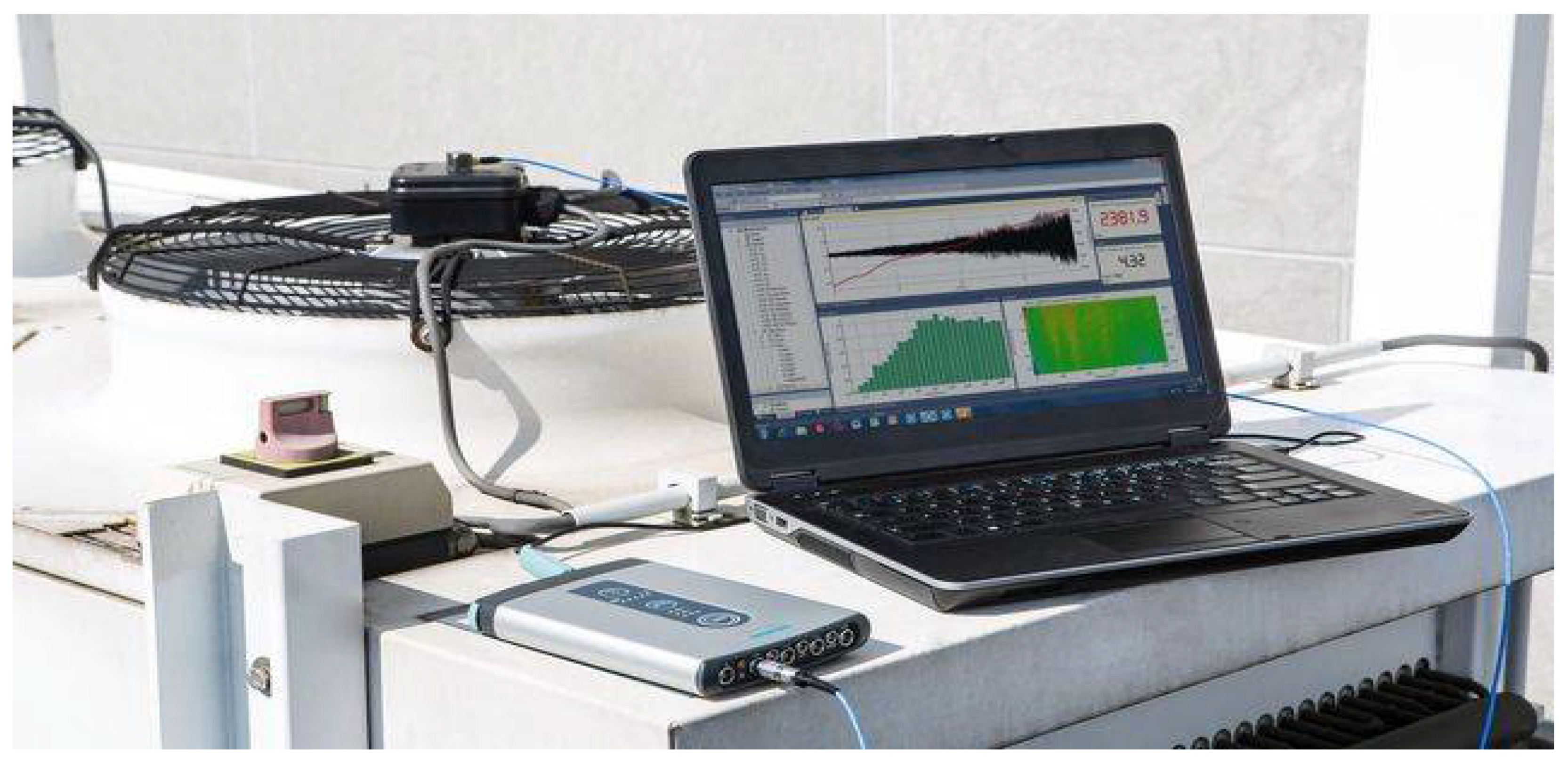
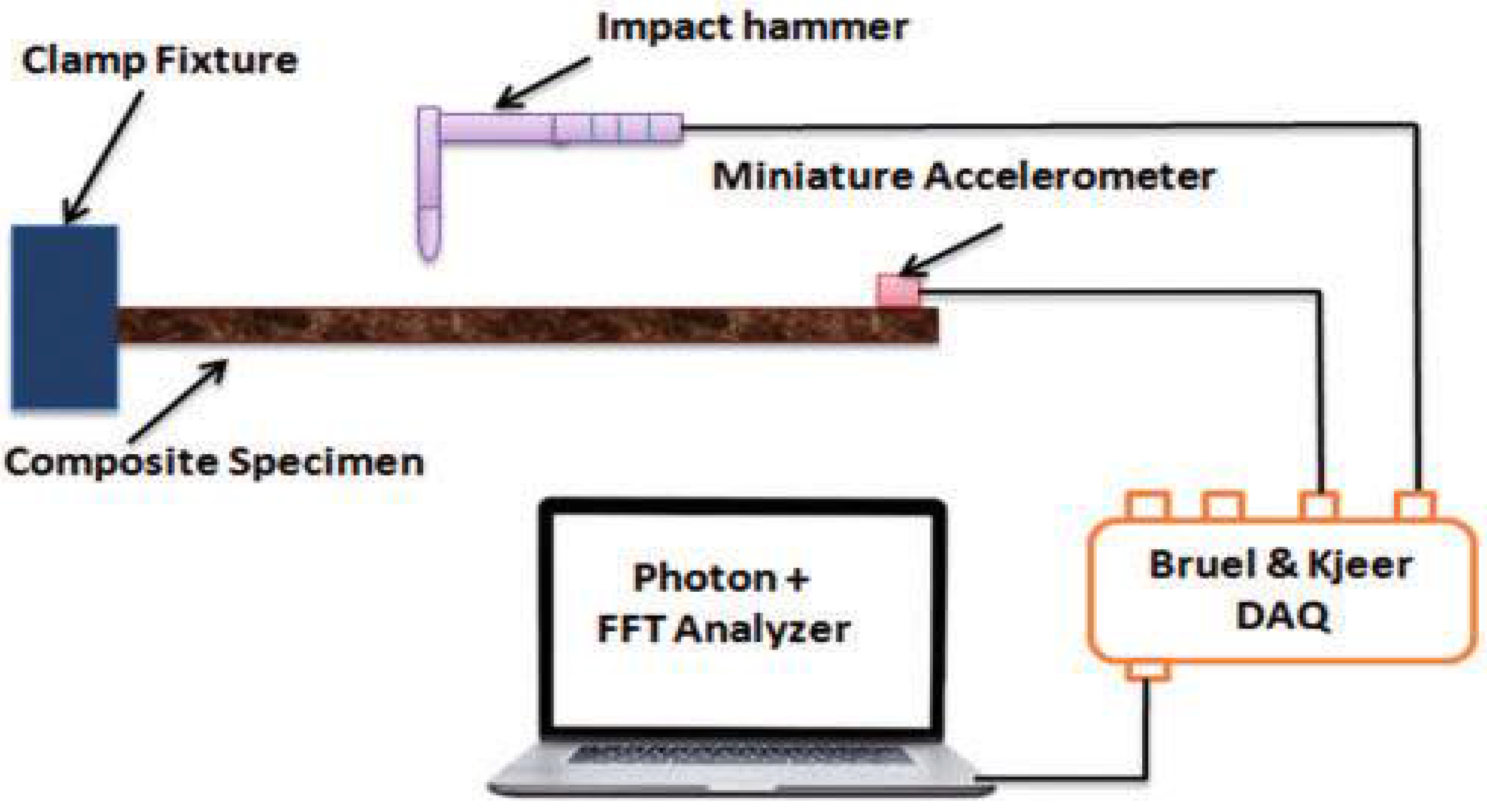
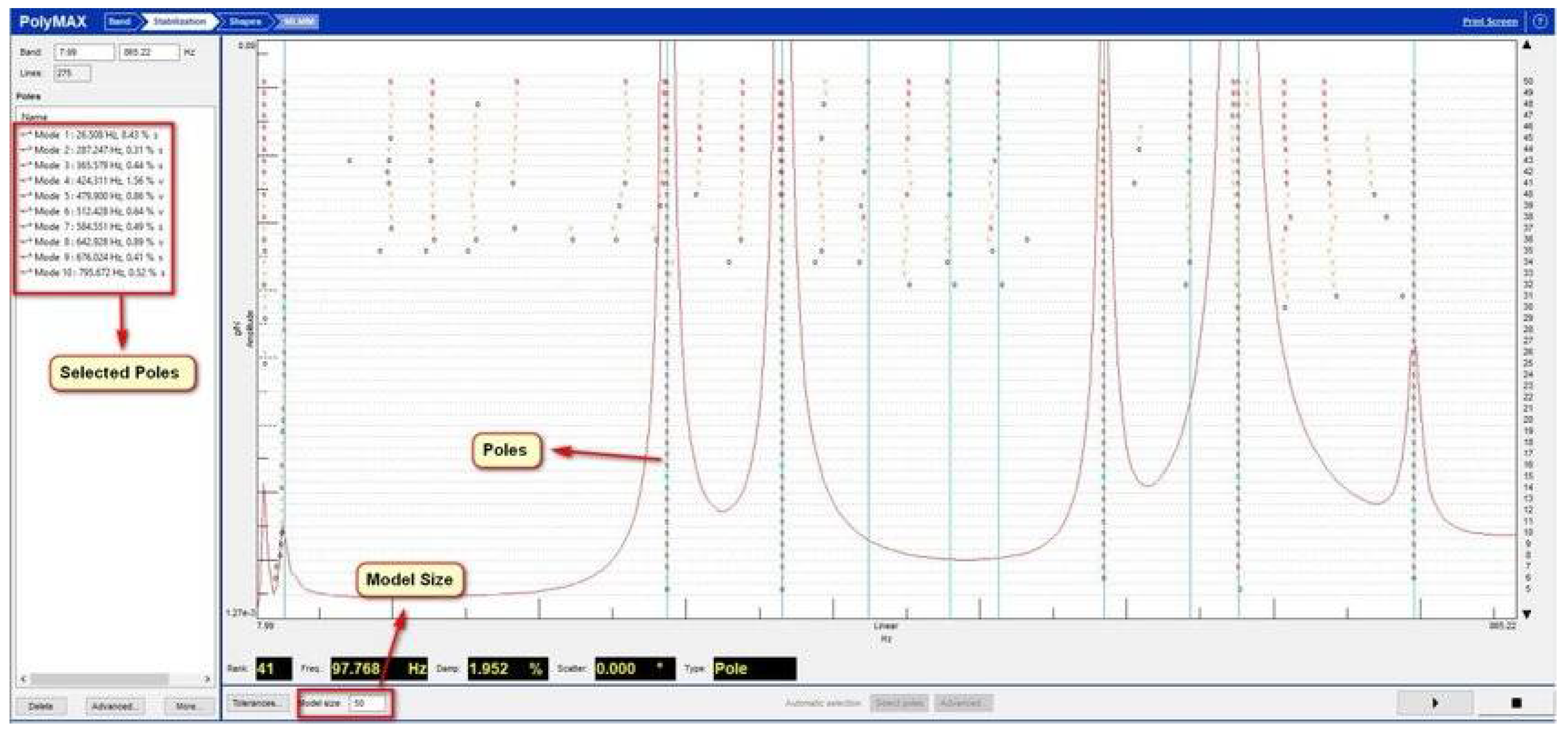

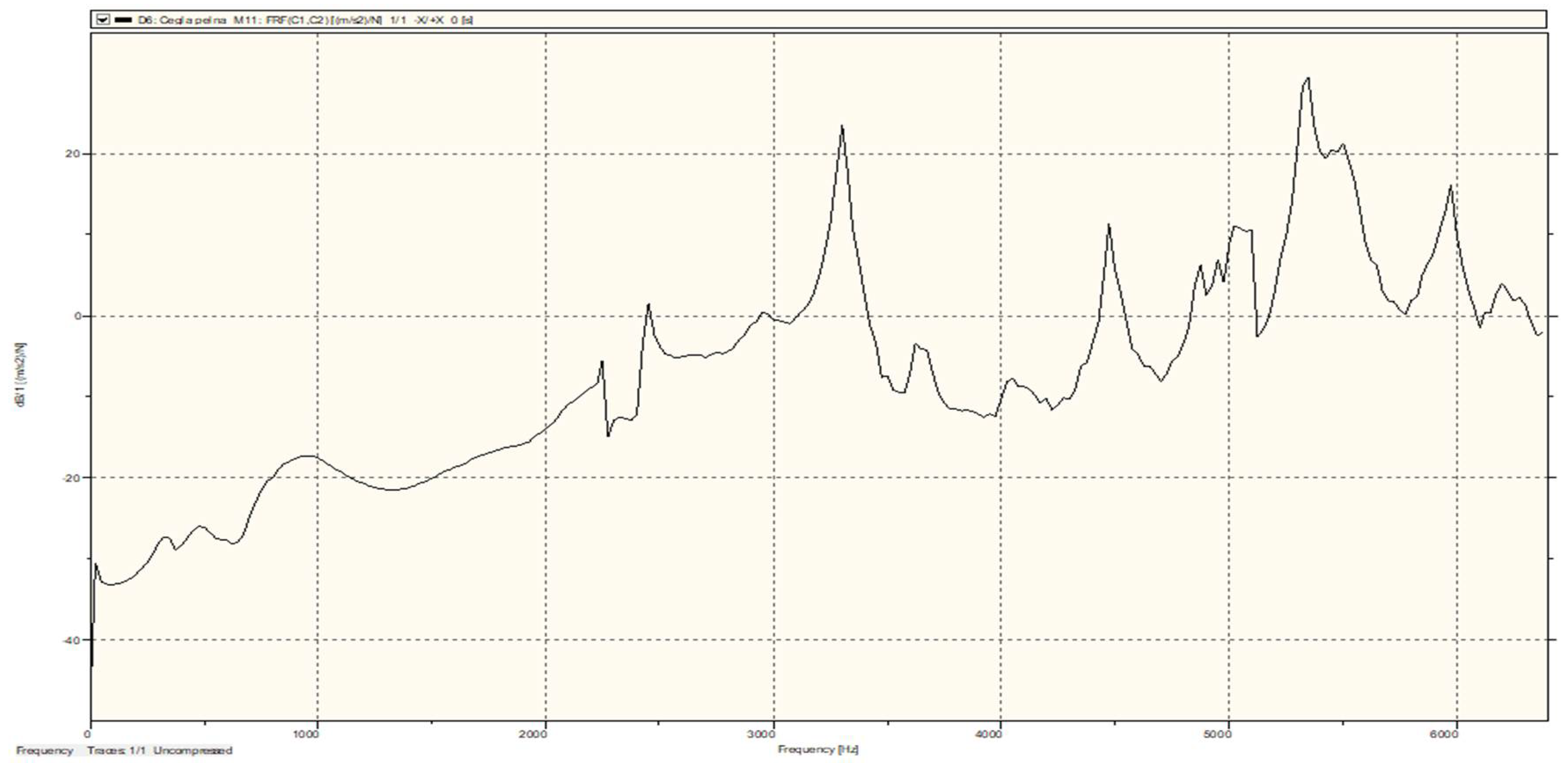
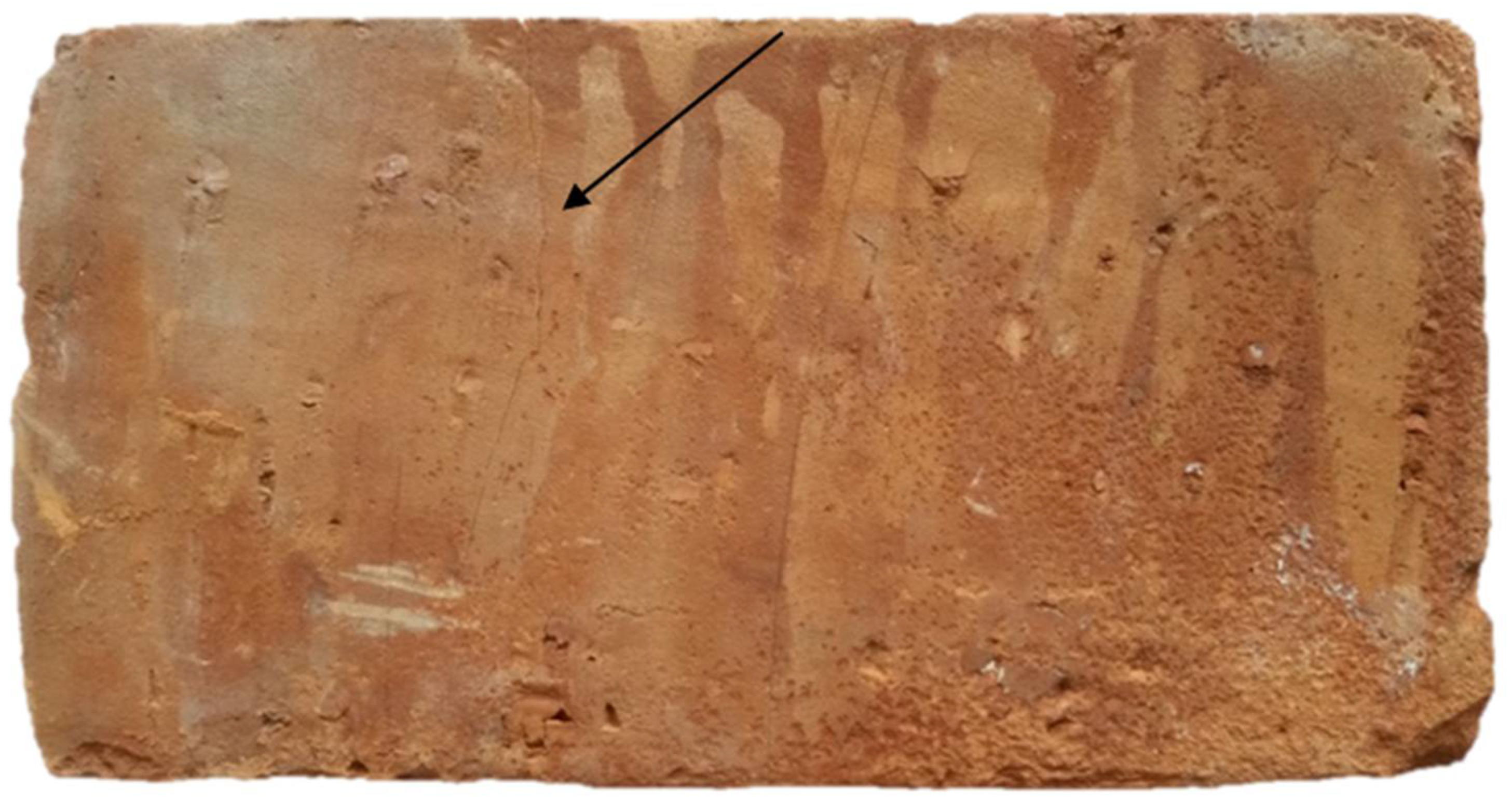

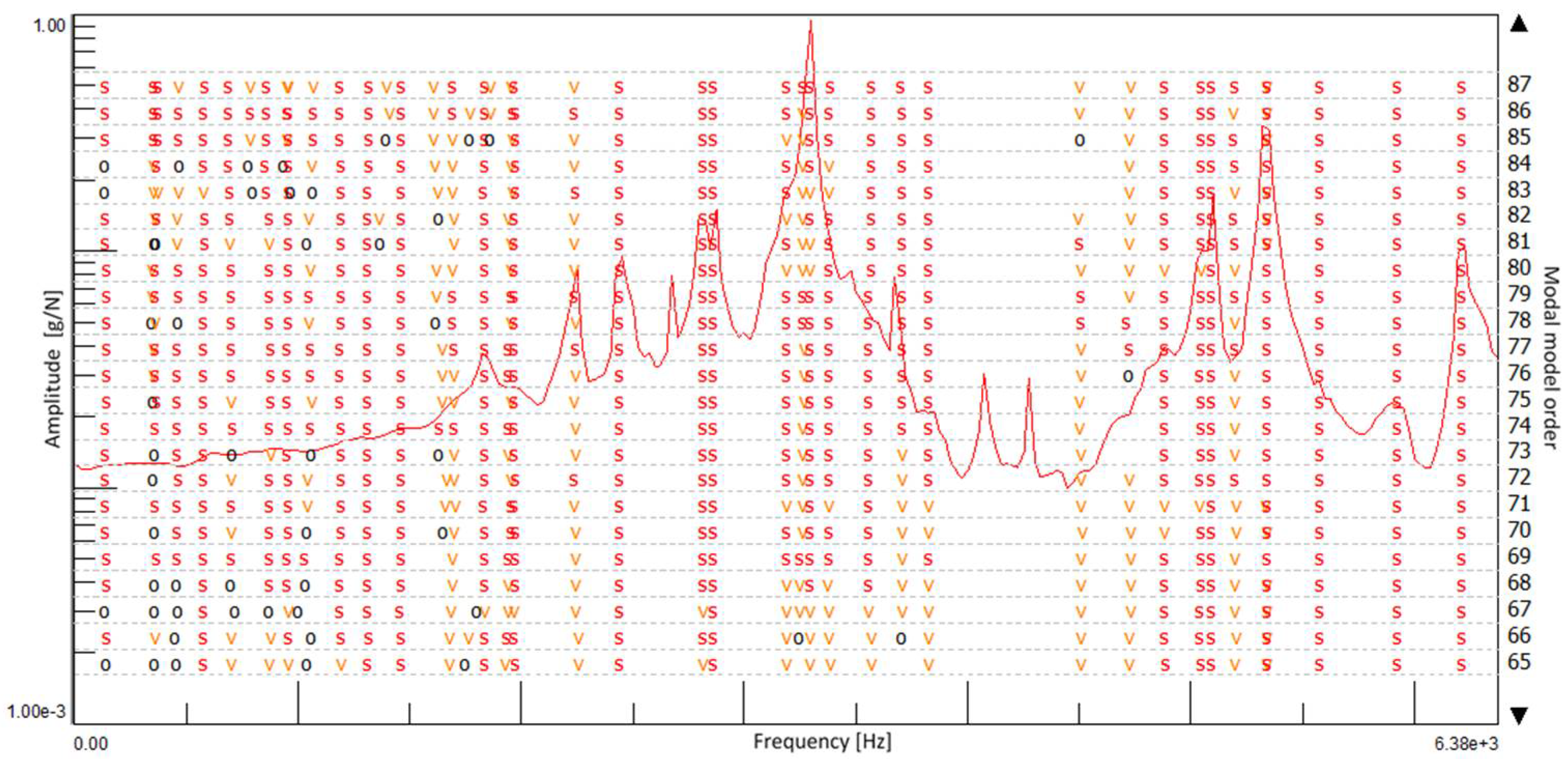

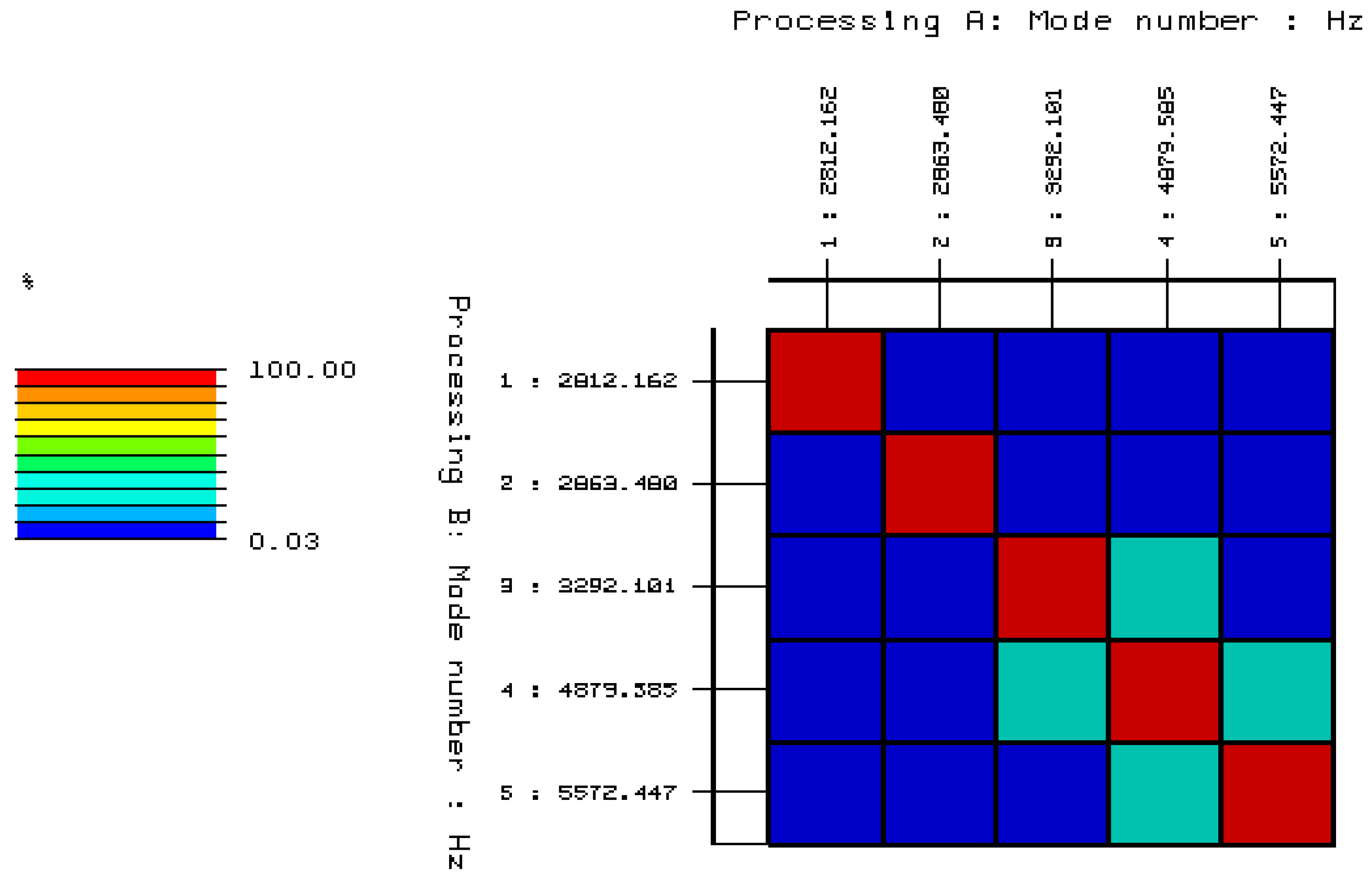

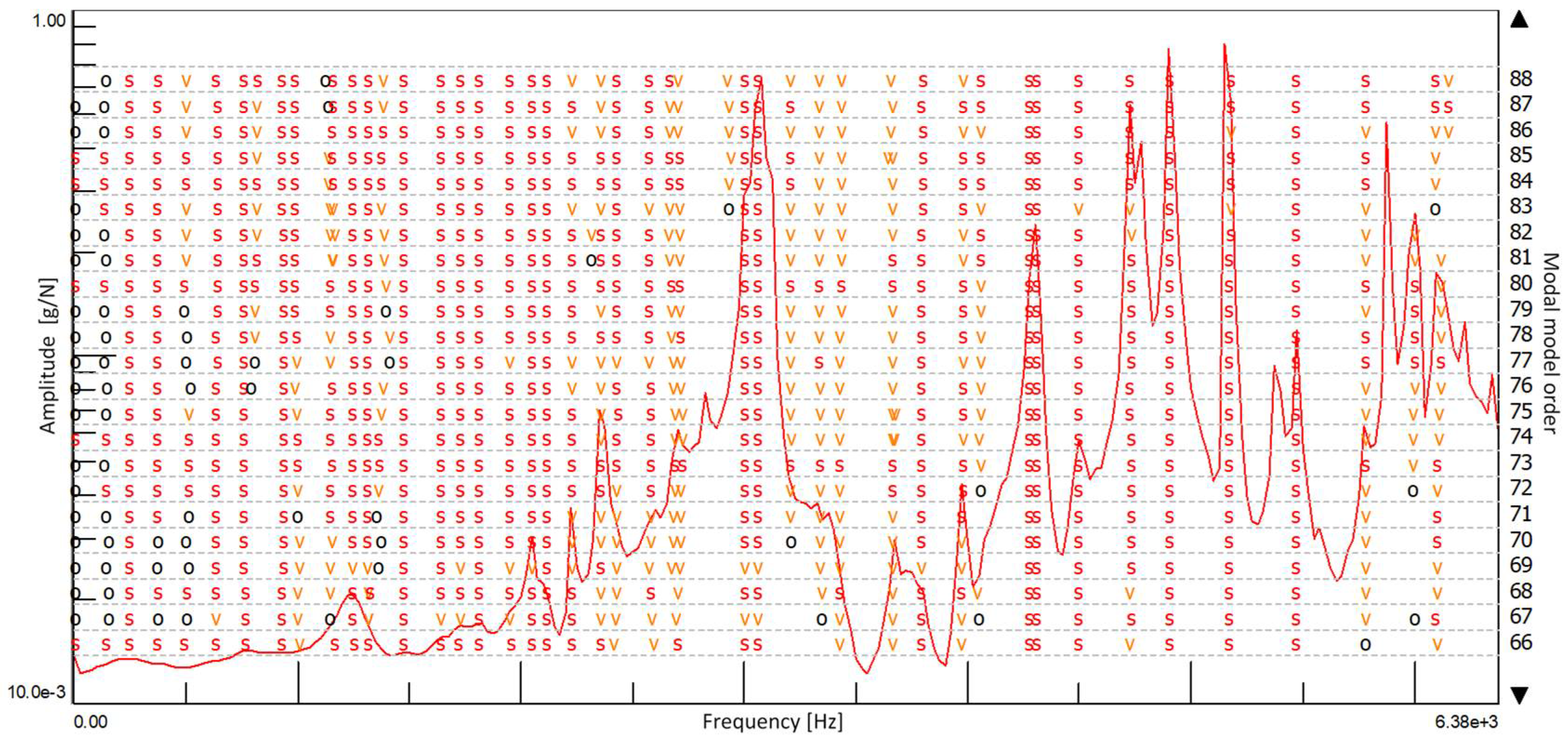
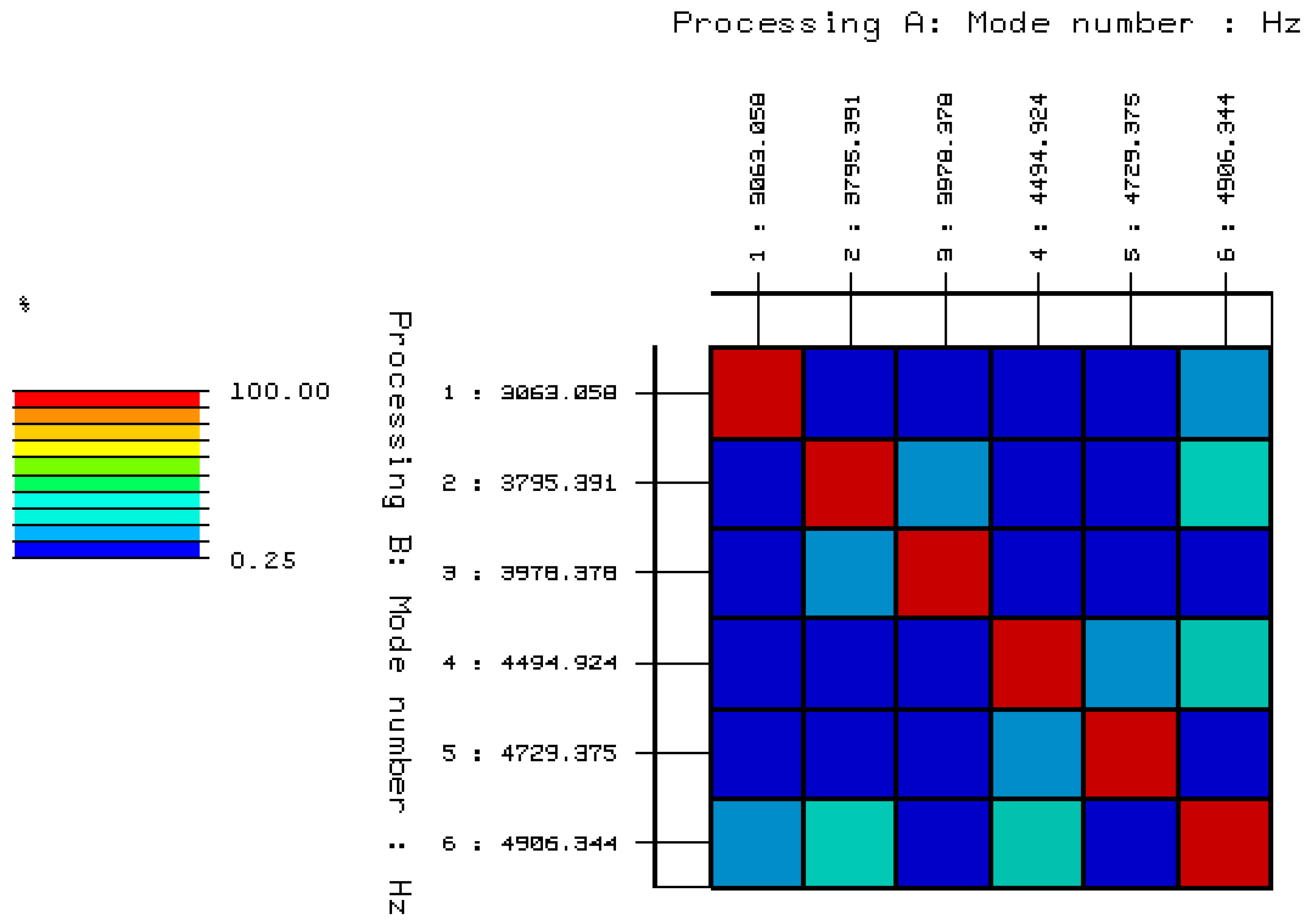

| Undamaged Full Brick | MODE 1 | MODE 2 | MODE 3 | MODE 4 | MODE 5 | |
|---|---|---|---|---|---|---|
| 2812.16 | 2863.48 | 3292.11 | 4879.58 | 5572.45 | ||
| MODE 1 | 2812.16 | 100 | 1.49 | 6.11 | 0.03 | 7.77 |
| MODE 2 | 2863.48 | 1.49 | 100 | 2.92 | 7.25 | 1.91 |
| MODE 3 | 3292.11 | 6.11 | 2.92 | 100 | 25.97 | 0.20 |
| MODE 4 | 4879.58 | 0.03 | 7.25 | 25.96 | 100 | 24.29 |
| MODE 5 | 5572.45 | 7.77 | 1.91 | 0.20 | 24.28 | 100 |
| Undamaged Solid Brick | ||
|---|---|---|
| Natural Vibrations | Frequency | Damping |
| (Hz) | (%) | |
| Mode 1 | 2812.162 | 0.44 |
| Mode 2 | 2863.480 | 0.82 |
| Mode 3 | 3292.101 | 0.13 |
| Mode 4 | 4879.585 | 0.14 |
| Mode 5 | 5572.447 | 0.34 |
| Damaged Full Brick | MODE 1 | MODE 2 | MODE 3 | MODE 4 | MODE 5 | MODE 6 | |
|---|---|---|---|---|---|---|---|
| 306.06 | 3795.39 | 3978.38 | 4494.92 | 4729.37 | 4906.34 | ||
| MODE 1 | 2812.16 | 100 | 6.10 | 0.25 | 0.45 | 0.37 | 16.17 |
| MODE 2 | 2863.48 | 6.10 | 100 | 18.58 | 0.76 | 0.51 | 31.12 |
| MODE 3 | 3292.11 | 0.25 | 18.59 | 100 | 1.67 | 0.36 | 3.34 |
| MODE 4 | 4879.58 | 0.45 | 0.76 | 1.67 | 100 | 12.80 | 22.03 |
| MODE 5 | 5572.45 | 0.37 | 0.51 | 0.36 | 12.80 | 100 | 2.46 |
| MODE 6 | 4906.34 | 16.17 | 31.12 | 3.34 | 22.03 | 2.46 | 100 |
| Damaged Solid Brick | ||
|---|---|---|
| Natural Vibrations | Frequency | Damping |
| (Hz) | (%) | |
| Mode 1 | 3063.058 | 0.23 |
| Mode 2 | 3795.391 | 0.72 |
| Mode 3 | 3978.378 | 0.13 |
| Mode 4 | 4494.924 | 0.29 |
| Mode 5 | 4729.375 | 0.12 |
| Mode 6 | 4906.344 | 0.16 |
Publisher’s Note: MDPI stays neutral with regard to jurisdictional claims in published maps and institutional affiliations. |
© 2022 by the authors. Licensee MDPI, Basel, Switzerland. This article is an open access article distributed under the terms and conditions of the Creative Commons Attribution (CC BY) license (https://creativecommons.org/licenses/by/4.0/).
Share and Cite
Żółtowski, M.; Rutkowska, G.; Liss, M.; Kałaczyński, T.; Krejsa, M. Vibration Energy Signal Information for Measure Dynamic Preferences of Ceramic Building Materials Using Experimental Modal Analysis Methodology. Materials 2022, 15, 1452. https://doi.org/10.3390/ma15041452
Żółtowski M, Rutkowska G, Liss M, Kałaczyński T, Krejsa M. Vibration Energy Signal Information for Measure Dynamic Preferences of Ceramic Building Materials Using Experimental Modal Analysis Methodology. Materials. 2022; 15(4):1452. https://doi.org/10.3390/ma15041452
Chicago/Turabian StyleŻółtowski, Mariusz, Gabriela Rutkowska, Michał Liss, Tomasz Kałaczyński, and Martin Krejsa. 2022. "Vibration Energy Signal Information for Measure Dynamic Preferences of Ceramic Building Materials Using Experimental Modal Analysis Methodology" Materials 15, no. 4: 1452. https://doi.org/10.3390/ma15041452
APA StyleŻółtowski, M., Rutkowska, G., Liss, M., Kałaczyński, T., & Krejsa, M. (2022). Vibration Energy Signal Information for Measure Dynamic Preferences of Ceramic Building Materials Using Experimental Modal Analysis Methodology. Materials, 15(4), 1452. https://doi.org/10.3390/ma15041452






